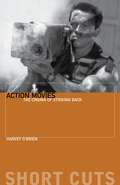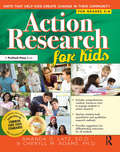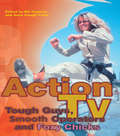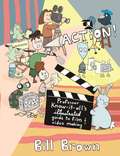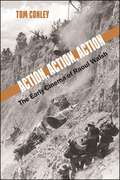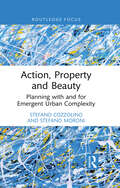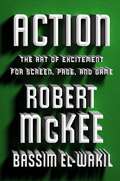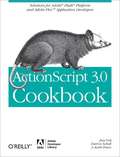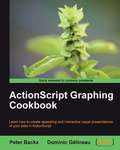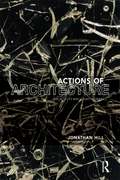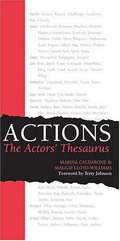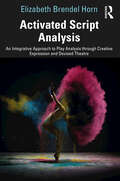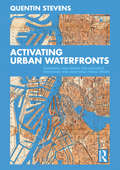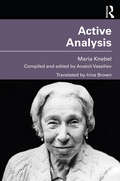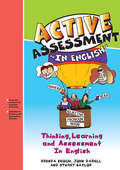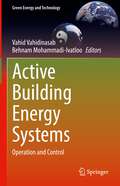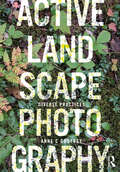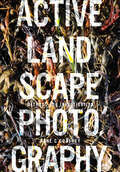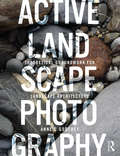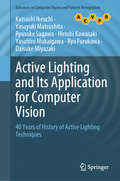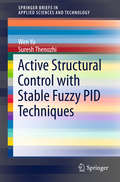- Table View
- List View
Action Movies: The Cinema of Striking Back
by Harvey O'BrienAction Movies: The Cinema of Striking Back is a study of action cinema, exploring the ethics and aesthetics of the genre with reference to its relatively short history. It moves from seminal classics like Bullitt (1968) and Dirty Harry (1971) through epoch-defining films like Rambo: First Blood Part II (1985) and Die Hard (1988) to revisions, reboots, and renewals in films like Kill Bill Vol. 1 (2003), Taken (2008), and The Expendables (2010).
Action Movies: The Cinema of Striking Back
by Harvey O'BrienAction Movies: The Cinema of Striking Back is a study of action cinema, exploring the ethics and aesthetics of the genre with reference to its relatively short history. It moves from seminal classics like Bullitt (1968) and Dirty Harry (1971) through epoch-defining films like Rambo: First Blood Part II (1985) and Die Hard (1988) to revisions, reboots, and renewals in films like Kill Bill Vol. 1 (2003), Taken (2008), and The Expendables (2010). The action genre is a fusion of form and content: a cinema of action about action. It is a cinema of the will, configured as a decisive reaction to untenable circumstances. Action heroes take up arms against the sea of troubles that beset them, safe in the knowledge that if they don't do it, nobody will. Though this makes the action movie profoundly disturbing as an embodiment of moral ideology, its enduring appeal proves the appetite for assurance remains undiminished, even in the wake of 9/11.
Action Research for Kids: Units That Help Kids Create Change in Their Community (Grades 5-8)
by Cheryll Adams Amanda O. LatzAction Research for Kids provides teachers with comprehensive, creative, and hands-on units to engage students in action research. Students will benefit from learning about quantitative and qualitative research practices that can make a real difference in their lives and those within their communities. Within this text, teachers can select a lesson or use whole units as students explore research methods such as survey research, experimental research, life history, and photovoice in fun lessons that ask them to create a library wish list, interview people in their communities, lobby for cookies in the cafeteria, and experiment with preservatives. Each lesson comes with detailed instructions and ideas for differentiation. Grades 5-8
Action TV: Tough-Guys, Smooth Operators and Foxy Chicks
by Anna Gough-Yates Bill OsgerbyFrom re-runs of 'TV classics' like The Avengers or Starsky and Hutch, to soundtracks, club nights and film remakes such as Mission Impossible II, the action series is enjoying a popular revival. Yet little attention has been paid to the history, nature and enduring appeal of the action series, and its place in popular culture, past and present.Action TV traces the development of the action series from its genesis in the 1950s. From The Saint to Knigh t Rider, contributors explore the key shows which defined the genre, addressing issues of audiences and consumption, gender and sexuality, fashion and popular culture. They examine the institutional and cultural factors influencing the action series, and relate shifts in the genre to other forms of popular culture including film, pop music, fashion and popular literature.Chapters include:* Of leather suits and kinky boots: The Avengers, style and popular culture* 'Who loves ya, baby?': Kojak, action and the great society*'A lone crusader in a dangerous world': heroics of science and technology in Knight Rider* Angels in chains? feminism, femininity and consumer culture in Charlie's Angels* 'Who's the cat that won't cop out?' Black masculinity in American action shows of the sixties and seventies
Action Whirligigs: 25 Easy-to-Do Projects
by Anders S. LundeWhirligigs -- those charming little wind-driven toys -- make excellent introductory woodworking projects because they are easy to do, inexpensive and -- most of all -- great fun! Hobbyists at all levels of ability will love creating the 25 delightful projects described in this book, from the simple Baking a Pie whirligig to the double-armed Woman at the Computer. Other figures include a Man/Woman Fishing, Oil Well Pump, Saluting the Flag, See-Saw, and Bucking Bronco. Easy-to-follow instructions and measured drawings explain everything from selecting and using proper tools and creating the driving mechanism to finishing and displaying the completed project.
Action!: Professor Know-it-all's Guide To Film And Video (Diy Ser.)
by Bill BrownHave you ever wanted to make your own movies? In this easy-to-read and lavishly illustrated volume, you will learn why movies move; how film and video cameras work; how to light and expose your shots to get the best results; how to create eye-pleasing compositions; and how to record crystal clear sounds. It's a do-it-yourself guidebook for film and video makers of all ages and experience levels.
Action, Action, Action: The Early Cinema of Raoul Walsh (SUNY series, Horizons of Cinema)
by Tom ConleyDirector of over 150 films from 1912 to 1964, Raoul Walsh was a core figure in Hollywood from its beginnings to the end of the studio system. Perhaps best known for such films as The Big Trail (starring John Wayne in his first leading role), High Sierra, and White Heat, Walsh cut his teeth under D. W. Griffith, and, like his contemporary John Ford, found a style and signature in his silent cinema and early talkies. Through close analysis of seven of his films, six shot between 1915 and 1933 and one a remake from 1956, and stressing the visual character of their settings and situations, Tom Conley examines how composition and montage—or action—often overtake the crisp narratives these films convey. Rife with contradiction, they ask us to see what makes them possible and how they contend with prevailing codes. Films discussed include Regeneration (1915); Sadie Thompson (1928) and a likely avatar, The Revolt of Mamie Stover (1956); The Cock-Eyed World (1929); The Big Trail (1930); Me and My Gal (1932); and The Bowery (1933).
Action, Property and Beauty: Planning with and for Emergent Urban Complexity
by Stefano Moroni Stefano CozzolinoWhat are the challenges and potential of complex and emergent urban systems? This book answers this question by shedding new light on the topics of emergence, complexity, and self-organisation and showing their interconnectedness with other concepts, such as property and beauty, which are usually considered separately. It contributes to the discussion by interpreting and explaining the nature of emergent urban phenomena and suggesting more appropriate design and planning measures.The book explores and untangles these crucial topics in a compact and accessible way by offering fresh interdisciplinary perspectives on the themes of action and interaction, self-organisation, property, neighbourhood adaptability, urban beauty, and suitable public planning and design interventions. It provides novel and crucial insights for students, researchers, and academics in Urban Studies, Planning Theory, Planning Ethics, Planning Law, Legal, Political and Human Geography, Urban and Regional Economics, Urban Sociology, and Urban Design. It is essential for anyone interested in exploring the emergent dynamics of complex urban contexts, as well as for those involved in developing various projects and measures who aim to consider the spontaneous nature of cities seriously.
Action: The Art of Excitement for Screen, Page, and Game
by Robert McKee Bassim El-WakilFrom the master of Story, Dialogue, and Character, ACTION offers writers the keys to propulsive storytelling. ACTION explores the ways that a modern-day writer can successfully tell an action story that not only stands apart, but wins the war on clichés. Teaming up with the former co-host of The Story Toolkit, Bassim El-Wakil, legendary story lecturer Robert McKee guides writers to award-winning originality by deconstructing the action genre, illuminating the challenges, and, more importantly, demonstrating how to master the demands of plot with surprising beats of innovation and ingenuity.Topics include: Understanding the Four Core Elements of ActionCreating the Action CastHook, Hold, Pay Off: Design in ActionThe Action MacguffinAction Set PiecesThe Sixteen Action SubgenresA must-add to the McKee storytelling library, ACTION illustrates the principles of narrative drive with precision and clarity by referencing the most popular action movies of our time including: Die Hard, The Star Wars Saga, Dark Knight, The Matrix, and Avengers: Endgame.
ActionScript 3.0 Cookbook: Solutions for Flash Platform and Flex Application Developers
by Joey Lott Darron Schall Keith PetersWell before Ajax and Microsoft's Windows Presentation Foundation hit the scene, Macromedia offered the first method for building web pages with the responsiveness and functionality of desktop programs with its Flash-based "Rich Internet Applications". Now, new owner Adobe is taking Flash and its powerful capabilities beyond the Web and making it a full-fledged development environment.Rather than focus on theory, the ActionScript 3.0 Cookbook concentrates on the practical application of ActionScript, with more than 300 solutions you can use to solve a wide range of common coding dilemmas. You'll find recipes that show you how to:Detect the user's Flash Player version or their operating systemBuild custom classesFormat dates and currency typesWork with stringsBuild user interface componentsWork with audio and videoMake remote procedure calls using Flash Remoting and web servicesLoad, send, and search XML dataAnd much, much more ...Each code recipe presents the Problem, Solution, and Discussion of how you can use it in other ways or personalize it for your own needs, and why it works. You can quickly locate the recipe that most closely matches your situation and get the solution without reading the whole book to understand the underlying code. Solutions progress from short recipes for small problems to more complex scripts for thornier riddles, and the discussions offer a deeper analysis for resolving similar issues in the future, along with possible design choices and ramifications. You'll even learn how to link modular ActionScript pieces together to create rock-solid solutions for Flex 2 and Flash applications.When you're not sure how ActionScript 3.0 works or how to approach a specific programming dilemma, you can simply pick up the book, flip to the relevant recipe(s), and quickly find the solution you're looking for.Adobe Developer Library is a co-publishing partnership between O'Reilly Media and Adobe Systems, Inc. and is designed to produce the number one information resources for developers who use Adobe technologies. Created in 2006, the Adobe Developer Library is the official source for comprehensive learning solutions to help developers create expressive and interactive web applications that can reach virtually anyone on any platform. With top-notch books and innovative online resources covering the latest in rich Internet application development, the Adobe Developer Library offers expert training and in-depth resources, straight from the source.
ActionScript Developer's Guide to PureMVC: Code at the Speed of Thought
by Cliff HallGain hands-on experience with PureMVC, the popular open source framework for developing maintainable applications with a Model-View-Controller architecture. In this concise guide, PureMVC creator Cliff Hall teaches the fundamentals of PureMVC development by walking you through the construction of a complete non-trivial Adobe AIR application.Through clear explanations and numerous ActionScript code examples, you’ll learn best practices for using the framework’s classes in your day-to-day work. Discover how PureMVC enables you to focus on the purpose and scope of your application, while the framework takes care of the plumbing in a maintainable and portable way.Get a detailed overview of the PureMVC process for developing your applicationModel the domain by designing the schema and creating framework-agnostic value objectsImplement framework-agnostic View components that expose an API of events and propertiesUse the Proxy pattern to keep track of value objects and hide service interactionFacilitate two-way communication between a View component and the rest of the applicationStitch the Model and View tiers together with command objects in the ControllerManage problematic View component life cycles, and learn how to reuse the Model tier
ActionScript Graphing Cookbook
by Dominic Gélineau Peter BackxStep-by-step instructions guide you from your very first graphical program to highly complex 3D presentations. Although a few recipes explain charts in Flex, this book is firmly focussed on using ActionScript code and data to draw graphs. The "ActionScript Graphing Cookbook" is aimed at any ActionScript developer who wants to add data visualization to their skill set. The reader should be familiar with ActionScript basics, but no deep knowledge of any graphical functions is required.
Actions of Architecture: Architects and Creative Users
by Jonathan HillDrawing on the work of a wide range of architects, artists and writers, this book considers the relations between the architect and the user, which it compares to the relations between the artist and viewer and the author and reader. The book's thesis is informed by the text 'The Death of the Author', in which Roland Barthes argues for a writer aware of the creativity of the reader. Actions of Architecture begins with a critique of strategies that define the user as passive and predictable, such as contemplation and functionalism. Subsequently it considers how an awareness of user creativity informs architecture, architects and concepts of authorship in architectural design. Identifying strategies that recognize user creativity, such as appropriation, collaboration, disjunction, DIY, montage, polyvalence and uselessness, Actions of Architecture states that the creative user should be the central concern of architectural design.
Actions: The Actors' Thesaurus
by Marina Caldarone Maggie Lloyd-WilliamsThis book is an essential companion for actors in rehearsal - a thesaurus of action words to revitalize performance.
Activated Script Analysis: An Integrative Approach to Play Analysis through Creative Expression and Devised Theatre
by Elizabeth Brendel HornActivated Script Analysis engages theatre students in traditional formative script analysis through a fusion of devised theatre and various modes of creative expression, dispelling the notion of script analysis as an isolated pen-to-paper task and reimagining it as a captivating and collaborative process. This book uses diverse, contemporary plays to model the script analysis process for each of four Theatrical Elements: Given Circumstances; Character; Setting; and Structure. By considering each of these elements, readers can uncover patterns and themes within a dramatic text. Woven throughout the study of each theatrical element are "Connections": Personal Connections, which encourage readers to explore a theatrical element within their own lives, as though their lives were a script; Play Connections, which make abstract ideas presented in script analysis concrete through theatre-based play; Professional Connections, which examine how a theatre professional might analyze a script within their own work; and Performative Connections, which provide the opportunity for students to explore a theatrical element through performance using devised theatre strategies. At the end of each chapter, readers are given the opportunity to analyze a text through the lens of a Theatrical Element and to express their findings through a variety of digital, written, visual, and performance-based modes of expression. Activated Script Analysis is designed for undergraduate theatre students and educators, to be used as the primary text in Script Analysis coursework or as a supplemental text in Acting or Directing courses. The book includes access to downloadable templates and example videos, available at www.routledge.com/9781032125398.
Activating Urban Waterfronts: Planning and Design for Inclusive, Engaging and Adaptable Public Spaces
by Quentin StevensActivating Urban Waterfronts shows how urban waterfronts can be designed, managed and used in ways that can make them more inclusive, lively and sustainable. The book draws on detailed examination of a diversity of waterfronts from cities across Europe, Australia and Asia, illustrating the challenges of connecting these waterfront precincts to the surrounding city and examining how well they actually provide connection to water. The book challenges conventional large scale, long-term approaches to waterfront redevelopment, presenting a broad re-thinking of the formats and processes through which urban redevelopment can happen. It examines a range of actions that transform and activate urban spaces, including informal appropriations, temporary interventions, co-design, creative programming of uses, and adaptive redevelopment of waterfronts over time. It will be of interest to anyone involved in the development and management of waterfront precincts, including entrepreneurs, the creative industries, community organizations, and, most importantly, ordinary users.
Active Analysis
by Maria KnebelActive Analysis combines two of Maria Knebel’s most important books, On Active Analysis of the Play and the Role and The Word in the Actor’s Creative Work, in a single edition conceived and edited by one of Knebel's most famous students, the renowned theatre and film director, Anatoli Vassiliev. This is the first English translation of an important and authoritative fragment of the great Stanislavski jigsaw. A landmark publication. This book is an indispensable resource for professional directors, student directors, actors and researchers interested in Stanislavski, directing, rehearsal methods and theatre studies more generally.
Active Assessment in English: Thinking Learning and Assessment In English
by Brenda Keogh John Dabell Stuart NaylorEverybody seems to be talking about Assessment for Learning. This book shows you how to do it.The thinking behind the highly influential ‘Assessment for Learning’ approach is translated into usable and practical strategies for all those teaching literacy in primary and secondary classrooms.The authors show how thinking, learning and assessment can be linked together in a creative and integrated fashion, so that thinking promotes learning, learning enables assessment to take place and assessment acts as a stimulus to both thinking and learning. Concise teachers’ notes for a broad range of dynamic techniques explain for each:what the approach ishow you use it for assessment how you can manage it in the classroomhow it helps with learning.Downloadable resources are included with all of the activities and ideas that can be used on Interactive Whiteboards. Active Assessment for English will prove inspiring reading for all literacy teachers at primary and secondary levels, LEA advisers and inspectors.
Active Building Energy Systems: Operation and Control (Green Energy and Technology)
by Behnam Mohammadi-Ivatloo Vahid VahidinasabThis book provides a comprehensive study on state-of-the-art developments in the control, operation, and market participation of active buildings (ABs). Active buildings can support the broader energy system by intelligent integration of renewable-based energy technologies for heating, cooling, electricity, and transport. This important reference analyzes the key features of modern control and operation techniques applied to these systems. Contributions from an international team of experts present practical methods with evidence and case studies from applications to real-world or simulated active buildings. Sample computer codes and analytical examples aid in the understanding of the presented methods. The book will support researchers working on the control and operation of buildings as an energy system, smart cities and smart grids, and microgrids, as well as researchers and developers from the building and energy engineering, economic, and operation research fields.Provides an in-depth review of building-level energy systems technologies;Covers codes, standards, and requirements for active building control systems;Includes sample computer code and analytical examples.
Active House: Smart Nearly Zero Energy Buildings (SpringerBriefs in Applied Sciences and Technology)
by Marco Imperadori Lone Feifer Graziano Salvalai Arianna Brambilla Federica BrunoneThe book provides an overview of the Active House (AH) vision, intended as a building design method “beyond” the passive approach for buildings of the future that will be more and more connected, smart and innovative. It offers a novel philosophical design approach in which buildings, new or renovated, are in balance with natural, renewable energies and become “concentrators-distributors” of energies instead of being consumers of resources. The book is composed of five chapters, providing information on fundamental aspects of innovations toward resource-efficient buildings, as well as case studies presenting the concept in practice. It demonstrates that a completely new design approach is possible, and that a turning point has been reached. Lastly, it shows how the AH Alliance, along with designers, institutions, industries and academies, is bringing a breath of fresh air to the world of construction.
Active Landscape Photography: Diverse Practices (Active Landscape Photography)
by Anne C GodfreyDiverse Practices, the third book in the Active Landscape Photography series, presents a set of unique photographic examples for site-specific investigations of landscape places. Contributed by authors across academia, practice and photography, each chapter serves as a rigorous discussion about photographic methods for the landscape and their underlying concepts. Chapters also serve as unique case studies about specific projects, places and landscape issues. Project sites include the Miller Garden, Olana, XX Miller Prize and the Philando Castile Peace Garden. Landscape places discussed include the archeological landscapes of North Peru, watery littoral zones, the remote White Pass in Alaska, Sau Paulo and New York City’s Chinatown. Photographic image-making approaches include the use of lidar, repeat photography, collage, mapping, remote image capture, portraiture, image mining of internet sources, visual impact assessment, cameraless photography, transect walking and interviewing. These diverse practices demonstrate how photography, when utilized through a set of specific critical methods, becomes a rich process for investigating the landscape. Exploring this concept in relationship to specific contemporary sties and landscape issues reveals the intricacy and subtlety that exists when photography is used actively. Practitioners, academics, students and researchers will be inspired by the underlying concepts of these examples and come away with a better understanding about how to create their own rigorous photographic practices.
Active Landscape Photography: Methods for Investigation (Active Landscape Photography)
by Anne C GodfreyHow can photography be transformed into an active process of investigation for landscape architecture and environmental design? The second book in Godfrey’s series, Active Landscape Photography, presents engaged photographic methods that turn photography into a rigorous, thoughtful endeavor for the research, planning and design of landscape places. Photography is the most ubiquitous and important form of representation in these disciplines. Yet photography is not specifically taught as a core skill within these fields. This book creates a starting point for filling this gap. Concepts and working methods from contemporary photography and critical cultural theories are contextualized into situations encountered in the daily practice of landscape architecture and environmental design. These methods can be integrated into practices in academic and professional settings or picked up and self-taught by an individual reader. Part I: Methods presents easily accessible approaches to photography creating a core set of active skills. Part II: Practices discusses working methods of specific contemporary photographers and extrapolates their practices into common extrapolates their practices into common planning and design situations. Contemporary photographers presented include Richard Misrach, Dawoud Bey, Duane Michals, Latoya Ruby Frazier, Mark Klett, Sophie Calle, Joe Deal, Robert Adams, Naima Green, Bernd and Hilla Becher, Stephen Shore, David Hockney, Amy Sherald, William Christenberry, Jeff Wall, and Sohei Nishino. Beautifully illustrated in full color with over 150 images by Godfrey, her students, and contemporary photographers, this book provides both clear guidelines for a set of diverse methods as well as a deeper discussion about the implications of making and using photography in environmental design for professionals, academics, students and researchers.
Active Landscape Photography: Theoretical Groundwork for Landscape Architecture
by Anne C GodfreyPhotographs play a hugely influential but largely unexamined role in the practice of landscape architecture and design. Through a diverse set of essays and case studies, this seminal text unpacks the complex relationship between landscape architecture and photography. It explores the influence of photographic seeing on the design process by presenting theoretical concepts from photography and cultural theory through the lens of landscape architecture practice to create a rigorous, open discussion. Beautifully illustrated in full color throughout, with over 200 images, subjects covered include the diversity of everyday photographic practices for design decision making, the perception of landscape architecture through photography, transcending the objective and subjective with photography, and deploying multiplicity in photographic representation as a means to better represent the complexity of the discipline. Rather than solving problems and providing tidy solutions to the ubiquitous relationship between photography and landscape architecture, this book aims to invigorate a wider dialogue about photography's influence on how landscapes are understood, valued and designed. Active photographic practices are presented throughout for professionals, academics, students and researchers.
Active Lighting and Its Application for Computer Vision: 40 Years of History of Active Lighting Techniques (Advances in Computer Vision and Pattern Recognition)
by Katsushi Ikeuchi Yasuyuki Matsushita Ryusuke Sagawa Hiroshi Kawasaki Yasuhiro Mukaigawa Ryo Furukawa Daisuke MiyazakiThis book describes active illumination techniques in computer vision. We can classify computer vision techniques into two classes: passive and active techniques. Passive techniques observe the scene statically and analyse it as is. Active techniques give the scene some actions and try to facilitate the analysis. In particular, active illumination techniques project specific light, for which the characteristics are known beforehand, to a target scene to enable stable and accurate analysis of the scene. Traditional passive techniques have a fundamental limitation. The external world surrounding us is three-dimensional; the image projected on a retina or an imaging device is two-dimensional. That is, reduction of one dimension has occurred. Active illumination techniques compensate for the dimensional reduction by actively controlling the illumination. The demand for reliable vision sensors is rapidly increasing in many application areas, such as robotics and medical image analysis. This book explains this new endeavour to explore the augmentation of reduced dimensions in computer vision. This book consists of three parts: basic concepts, techniques, and applications. The first part explains the basic concepts for understanding active illumination techniques. In particular, the basic concepts of optics are explained so that researchers and engineers outside the field can understand the later chapters. The second part explains currently available active illumination techniques, covering many techniques developed by the authors. The final part shows how such active illumination techniques can be applied to various domains, describing the issue to be overcome by active illumination techniques and the advantages of using these techniques. This book is primarily aimed at 4th year undergraduate and 1st year graduate students, and will also help engineers from fields beyond computer vision to use active illumination techniques. Additionally, the book is suitable as course material for technical seminars.
Active Structural Control with Stable Fuzzy PID Techniques (SpringerBriefs in Applied Sciences and Technology)
by Wen Yu Suresh ThenozhiThis book presents a detailed discussion of intelligenttechniques to measure the displacement of buildings when they are subjected tovibration. It shows how these techniques are used to control active devicesthat can reduce vibration 60-80% more effectively than widely used passiveanti-seismic systems. After introducing various structural control devices andbuilding-modeling and active structural control methods, the authors proposeoffset cancellation and high-pass filtering techniques to solve some commonproblems of building-displacement measurement using accelerometers. The mostpopular control algorithms in industrial settings, PD/PID controllers, are thenanalyzed and then combined with fuzzy compensation. The stability of thiscombination is proven with standard weight-training algorithms. These conditionsprovide explicit methods for selecting PD/PID controllers. Finally, fuzzy-logicand sliding-mode control are applied to the control of wind-induced vibration. The methods described are supported by reports of experimental studies on atwo-story building prototype. This book is avaluable resource for academic researchers interested in the effects of controland mechatronic devices within buildings, or those studying the principles ofvibration reduction. Practicing engineers working on the design andconstruction of any sort of high-rise or vulnerable building and concerned withthe effects of either wind or seismic disturbances benefit from the efficacy ofthe methods proposed.
